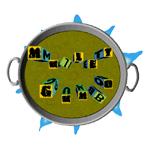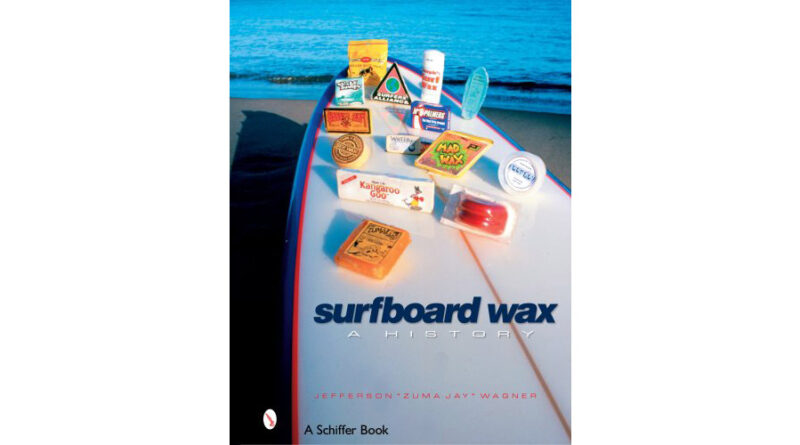Surf Wax – all you need to know
Some things in surfing might be luxuries and some things might be optional, however surf wax is a necessity. Without surf wax the top of a surfboard is slick and will not allow a surfer to stay on the board. These days there are quite a few companies and many different varieties of wax, but that was not always the case.
The history of Surf Wax
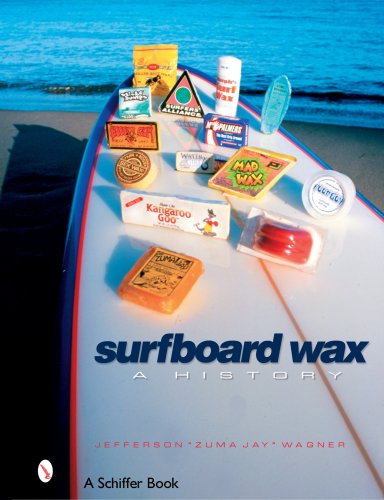 Having a specialty product for waxing your surfboard was not always an option. Candles were the wax of choice in the early 1900s and later in the 1930s paraffin canning wax was popular. Paraffin was cheap and available in most supermarkets but it was very hard and thus had to be heated and melted onto the deck. It created a slippery surface very easily so sand would be rubbed on the deck to scratch the paraffin and provide more traction. In the 1960s it was discovered that adding motor oil to paraffin would soften it enough to allow it to be applied more easily. This also created a bumpy uneven surface that enhanced traction. Further changes came from use of pliable waxes similar to beeswax as well as lower melting paraffin combined with oil.
Having a specialty product for waxing your surfboard was not always an option. Candles were the wax of choice in the early 1900s and later in the 1930s paraffin canning wax was popular. Paraffin was cheap and available in most supermarkets but it was very hard and thus had to be heated and melted onto the deck. It created a slippery surface very easily so sand would be rubbed on the deck to scratch the paraffin and provide more traction. In the 1960s it was discovered that adding motor oil to paraffin would soften it enough to allow it to be applied more easily. This also created a bumpy uneven surface that enhanced traction. Further changes came from use of pliable waxes similar to beeswax as well as lower melting paraffin combined with oil.
By the mid 1960s Mike Doyle, Rusty Miller, and Garth Murphy formed the company Surf Research and their first product was surf wax. They created more attractive change when they added color and a strong scent of bayberry to the wax. Steve Knorr who was a third generation candle maker helped them formulate this custom surf wax with soft waxes for cold water and harder waxes for warm. They called it Waxmate and added purple coloring and each bar came with a fortune as well.
After that, by the early 1970s surfing became more popular and the larger market of surf industry saw several companies forge ahead into the surf wax business. Want to know more? Then check out this book: Surfboard Wax: A History You can also check out this Surf Wax Museum.
Types of Surf Wax
There are basically three different types of surf wax today.
-
Traditional waxes – these have higher amounts of paraffin and are therefore harder and less sticky
-
Sticky waxes – these contain more softeners and have other substances that increase the stickiness
-
Very soft – these newer waxes are softer and stickier than others
The ideal wax will allow a surfer to quickly apply it and create a thick build up which will create superior traction underfoot. The wax must also be able to handle different water temperatures. In warmer water conditions a wax with a higher melting point is desired. These waxes will contain more paraffin and less of the softening agents. In cold water conditions a softer wax is preferred and these waxes will have more softeners and less paraffin. There are also base waxes that are applied to new boards or old boards that have been stripped of old wax. The base wax allows for better and more even coverage of the surf wax.
The Big 3 Wax Companies
Surf Research
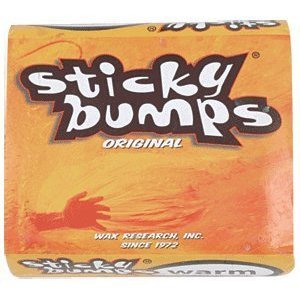 Starting in 1972 Wax Research began to produce waxes for surfboards. They are a family owned business operating in Carlsbad, CA. They offer several types of surfboard wax under the brand name of Sticky Bumps.
Starting in 1972 Wax Research began to produce waxes for surfboards. They are a family owned business operating in Carlsbad, CA. They offer several types of surfboard wax under the brand name of Sticky Bumps.
Sticky bumps warm water original formula is great for water temperatures over 69 degrees. However, if you are typically in much warmer water you will probably prefer the tropical formula which is great for water temperatures above 75 degrees, something that Texas coastal surfers deal with much of the year.
For cold water they have the cool/cold water which is good for temperatures below 68 degrees. For water below 60 degrees you will want the cold water version you are starting with a new board or if you have cleaned the wax off an old board then you will likely want to start with the Basecoat wax which will work with all temperatures and help your wax stay on longer. Besides the original formula, they also make it in Day Glo colors red, pink, blue, green, orange and yellow.
I like the Sticky Bumps brand as it is easy to apply with each bar breaking into two pieces and it does not have a strong odor like some waxes. It is my current favorite wax.
Mr. Zog’s
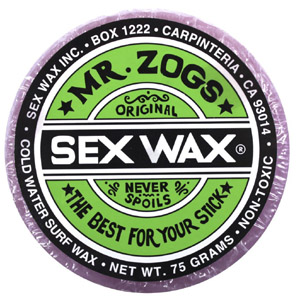 Probably one of the most recognizable brands is the Mr. Zog’s Sex Wax. Created by Frederick Charles Herzog, III in the early 1970’s with the help of a local chemist Nate Skinner. With its suggestive name and surf tested formula, Zog’s Sex Wax became a world wide hit. If you are wondering why this wax comes in a round shape versus the square shape of the other types it is because when they were first making this wax they poured the melted wax into tuna cans to set.
Probably one of the most recognizable brands is the Mr. Zog’s Sex Wax. Created by Frederick Charles Herzog, III in the early 1970’s with the help of a local chemist Nate Skinner. With its suggestive name and surf tested formula, Zog’s Sex Wax became a world wide hit. If you are wondering why this wax comes in a round shape versus the square shape of the other types it is because when they were first making this wax they poured the melted wax into tuna cans to set.
Not only does this brand have a catchy name, the original formula for each water temperature has 4 different scents available, Coconut, Strawberry, Grape, and Pineapple. Their Cold water version is for temperatures below 58 degrees. The Cool Water is for between 56 and 68 degrees. Warm water is for 66 – 78 degrees and Tropical is for above 75 degrees.
Aside from the original formula, there is also a version called Quick Humps which comes in 5 water temperatures from frigid, below 50 degrees to tropical.
Sex Wax was the first surfboard wax I can remember using. It is great that it comes in various scents so you can find one you like.
Mrs. Palmers
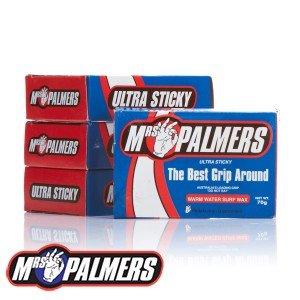 Mrs Palmers was started in 1988, in Australia. They have a cold water version for temperatures below 58 degrees, a cool water type for between 58 to 68 degrees , warm water version for between 68 – 75 degrees and tropical version for above 75 degrees. In addition to these formulas, there is also a base coat which will help the top coat of wax stay on your board better.
Mrs Palmers was started in 1988, in Australia. They have a cold water version for temperatures below 58 degrees, a cool water type for between 58 to 68 degrees , warm water version for between 68 – 75 degrees and tropical version for above 75 degrees. In addition to these formulas, there is also a base coat which will help the top coat of wax stay on your board better.
I started using Mrs. Palmers wax after switching from Sex Wax and I liked the convenience of being able to break the rectangular bars into pieces so I could leave part of the bar in the car instead of having a large chunk of wax with me out in the line up.
Now these are not all the wax companies out there, but all three of these companies make a quality product and have done so for many, many years. They have original formulas as well as newer formulations that take advantage of newer agents to make the wax easier to apply, longer lasting and/or better traction. Other wax companies also make great surfboard waxes and in later posts I will go over some of them, but quite frankly I almost always choose one of these three companies for my surf wax.
The most important thing to keep in mind is that you need wax. There is nothing worse than getting to the beach and all set to go into the lineup when you realize you don’t have any wax. Sometimes you might get lucky and find a piece of wax washed up in the tide after being lost by another surfer. Most times though you are left trying to rough up what wax there is on your board with a handful of sand.
Buying wax is one of the chief reasons surfers visit surf shops and it used to be that a bar of wax would only cost $1. These days though one dollar is greater than the wholesale price to the surf shops themselves, so expect to pay at least $2 if not more. We have switched from buying wax through the surf shops to ordering online and taking advantage of free shipping. It is nice to have all of those bars of wax sitting there waiting for when we need them.
Leave us a comment and let us know your favorite brand of surf wax.
(This post contains affiliate links. As an Amazon Associate we earn from qualifying purchases.)
